Issue 159 – May 2025
NEWS: WORTHY

Best-Selling Author and Burnout Expert Erin Stafford to Deliver Keynote at Educational Forum
The California JPIA is pleased to announce that Erin Stafford is the keynote speaker at the 30th Annual Risk Management Educational Forum. Erin’s transformative keynotes are designed to energize, inspire, and equip leaders to rise above challenges and maintain peak performance.
With increasing demands, evolving challenges, and public scrutiny, burnout among government leaders and teams is on the rise. Without the right tools to navigate stress, productivity, morale, and innovation can take a hit. With Erin’s dynamic presence and actionable insights, she addresses the unique challenges government professionals face. Her tailored message empowers attendees to achieve sustainable success while staying connected to their purpose.
Drawing from her personal experiences with burnout, decades of leadership in hyper-growth organizations, and insights from interviews with Olympians, Fortune 100 CEOs, and top experts, Erin offers strategies to ignite purpose, foster resilience, and cultivate lasting success.
This year’s Forum, titled Class of ’95: Not So Clueless About Risk, will be held at the Omni La Costa Resort in Carlsbad from October 1 through 3, 2025. Registration for the Forum opens later this spring.
If you have questions about the Forum, visit the Risk Management Educational Forum page on the Authority’s website or email us.
Print Article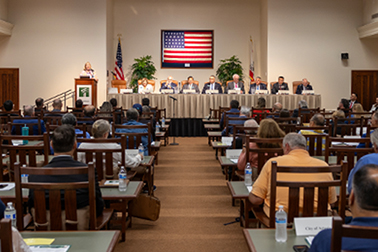
Annual Meeting of the Board of Directors
Please join the California JPIA for the Annual Meeting of the Board of Directors on Wednesday, July 23, 2025, at 7:00 p.m.
The Authority is governed by a Board of Directors and an elected nine-member Executive Committee. The Board of Directors consists of one elected official appointed by each member agency. Member cities, joint powers authorities, and special districts actively guide the Authority, ensuring that value-based decisions that benefit the entire membership are made.
The Annual Meeting will include the election of the Authority’s president and three Executive Committee members, recognition of the 2025 Risk Management Award winners, and a presentation about the Authority’s strategic plan and operational overview.
The meeting will be held at the Authority’s La Palma campus. A buffet dinner will be served al fresco at 5:30 p.m., with the Board of Directors meeting immediately following. Voting delegates and up to one additional member representative are eligible to receive lodging and travel reimbursement for attending the meeting. A $100 stipend will be provided to each member agency’s voting delegate or alternate attending the meeting.
Registration for the Annual Meeting of the Board of Directors will open in early June. For questions or assistance, please contact Agency Clerk Veronica Ruiz.
Print Article
Best Practices for Agencies to Plan and Host Safe and Successful Parades
Parades bring communities together in a spectacle of color, music, and excitement. However, planning and hosting a parade requires careful coordination and preparation to ensure a smooth and successful event. From permits and logistics to safety measures and community engagement, the California JPIA recommends that member agencies take a proactive approach to ensure a seamless parade experience for all participants and spectators alike.
Risk exposures associated with parades frequently are linked to interactions between individuals and vehicles. Common hazards include participants falling from floats or being struck by vehicles and spectators being injured by floats or vehicles along the parade route (tossed candy and toys often exacerbate this issue). Flammable items used on floats and by parade performers may increase the risk of fire. Inadequate crowd management also is a concern; large gatherings of people raise the odds of dangerous occurrences.
“When planning a parade, the last thing a public agency wants to think about is something going wrong,” said Senior Risk Manager Maria Galvan. “However, risk factors including numerous children, moving vehicles, crowds of spectators, distracted pedestrians, and float riders can lead to the possibility of adverse outcomes that may affect an agency’s loss history and reputational risk.”
Including risk management tools in parade planning and execution, and collaboration between event planners, community organizations, and risk managers, can help agencies implement plans to reduce exposures and prevent losses. Coordination with public safety departments, including police, fire, and emergency medical services, is also key to a safe parade. For example, “If You See Something, Say Something” campaigns can stress the importance of participants and spectators reporting suspicious activity to security or public safety.
The California JPIA recommends that members require organizations and individual parade participants to execute a waiver and release of liability. For minor participants, a parent or legal guardian must execute the waiver. Agencies can use wrist bands to track which individuals have provided an executed waiver.
“While having every participant sign a waiver may sound like an administrative burden,” said Galvan, “it is possible and an important risk management tool that can protect your agency from potential liability.”
Agencies should also consider risk transfer as a risk management tool. Parade events often involve multiple parties, such as vendors, bands, and concessionaires, who should obtain proper licenses and permits and comply with local ordinances and regulations. To minimize potential liability resulting from other parties’ activities at parades, permit applications, and/or formal agreements with insurance requirements and an indemnification clause are imperative. Evidence of insurance should include an endorsement to the general liability insurance policy naming your agency as an additional insured. The required insurance limits should be based on the exposures presented by the activity or event.
“For example,” said Galvan, “a pyrotechnic company should provide higher limits of general liability insurance than a small band, since the risks associated with fireworks are far greater. It is important to know that only including an indemnification clause (with no insurance requirement) in permits and agreements does not ensure appropriate risk transfer. Without insurance, a vendor may not have the financial resources to support the indemnification of your agency in the event of a loss or claim.”
The City of Monrovia hosts two parades annually and advises that planning and preparation are key.
“Planning is key to a successful parade,” said Community Services Director Tina Cherry. “With so many moving parts and different groups and organizations, thinking through every detail is critical, as is ensuring that those working the event are informed. The more you empower others to solve issues in the moment, the smoother things will go.”
But Cherry added that certain circumstances are difficult to anticipate. For example, one year, a car club entered its parade with inappropriate images painted on the vehicles.
“Making sure someone has eyes on all entries is critical,” she urged. “I would never have thought someone would bring such vehicles into a family-friendly holiday parade…but it happened. While you cannot plan for everything, you can learn from every experience.”
Monrovia’s planning typically begins with a debrief of the prior year’s event. Key stakeholders, including police, fire, public works, recreation, volunteers, and the event committee, discuss what worked, what did not work, and what could be improved. The city also hosts a meeting during which the staff who will be working on the event review the details.
“While they all do not need to be experts on everything, we find that general knowledge of what, who, when, and where is very helpful,” said Cherry. “We identify key players to lead various components, which creates buy-in and diffuses questions.”
Another critical planning element leveraged by Monrovia is mind-mapping. Staff think about how the experience will be for various stakeholders, ranging from dignitaries and spectators to parade participants and public safety, and envision the event from the different perspectives so they can anticipate and adapt accordingly.
The Monrovia Days Parade, which celebrates the city’s birthday on a Saturday morning in May, typically includes 65 entries. The parade’s purpose is to highlight the community’s youth, including “Scholars and Champions” within the school district. It also provides an opportunity to showcase programs and activities.
Monrovia’s Holiday Parade is held in the evening on the first Thursday in December. It is well attended, with about 80 entries and several thousand spectators. Cherry said that it is often looked at as the “real” kick-off to the holidays and that everyone is in the holiday spirit.
Both parades share a staging area and route. In addition to accommodating a live audience, the events are aired on KGEM-TV, Monrovia’s public access channel, to extend access for residents unable to attend in person. Each parade includes private and rented vehicles, horse-drawn carriages, bands, show horses, and, said Cherry, “a lot of people.”
“Parades are a terrific community gathering,” she said. “They bring people together, highlight our local non-profits, promote local businesses, create community pride, build character in the youth, and, most importantly, help to create a community that offers a premier quality of life.”
To ensure that risk management best practices are in place for the parades, Monrovia has leveraged the Authority’s educational resources, including in-person programming, as well as guidance from Senior Risk Manager Maria Galvan, to whom the city sends contracts, waivers, and other documents to ensure the reduction of risk whenever possible. Galvan has also hosted training sessions in Monrovia, providing updates on best practices as well as information about how to reduce the agency’s risk.
“We really appreciate Maria and all of her help and support,” said Cherry. “We rest assured knowing that the Authority has our back and will evaluate the risk for our organization while also helping us do the things we like to do.”
For other California JPIA member agencies planning parades, Cherry offered this advice:
- “Plan, prepare, and build a strong team. You cannot do it all alone. Having dedicated and resourceful teammates will make everything easier.”
- “Manage your expectations. Things will go wrong: Expect it and learn and grow from it.”
- “Have a plan for cancellation. Things happen. For example, know if your event will happen in rain or shine or if you will reschedule due to inclement weather.”
The International City/County Management Association, the National Association of Counties, and the National League of Cities partnered to develop Top 12 Things to Include in Parade Safety Plans: A Guide for Cities, Counties, and Local Governments to help municipalities ensure public safety at parades, festivals, and special activities that take place in their communities. The document highlights some of the critical elements to include in local ordinances or permitting regulations to guide the preparation and execution of these events. The 12 items include regulations and requirements, key contacts, safety and emergency response plans, route, vehicles, drivers, participants, animals, assembly and disassembly, viewing stands and vendors, insurance, and debris removal.
The California JPIA has developed a set of Parade Rules and Guidelines, including entry application and waiver templates. The recommendations detail requirements for registration and line-up procedures, participant actions and behaviors, vehicles and drivers, animal condition and care, and disbandment traffic patterns.
“The guidelines do not cover every potential parade exposure,” cautioned Galvan. “Staff planning a parade should consider unique hazards and local ordinances as well as guidance from local public safety departments including law enforcement and fire.”
For more information, please contact your senior risk manager.
Print Article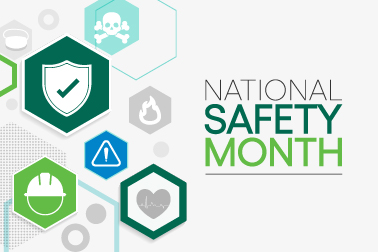
June is National Safety Month: Stay Prepared with the California JPIA
Established in 1996 by the National Safety Committee, this observance aims to prevent avoidable risks and deaths nationwide. The Authority shares this mission in public service, making June an ideal time to assess risks and utilize resources from the California JPIA.
The Authority offers a variety of in-person, virtual instructor-led, and online self-paced training modules. Some of the lesser-known safety training opportunities include:
- Chain Saw Safety Training
- Emergency Preparedness and Fire Extinguisher
- Encountering & Serving Individuals Who Are Unhoused
- Hearing Conservation
- Heat Illness Prevention
- Heat Illness Prevention Employee Training for Indoor Environments
- Homeless Encampment Clean-up Safety
- Library Service, Safety, and Security
- Pepper Spray Defense
- Sanitary Sewer Overflow (SSO) Response Training
- Silica Dust Training
- Wood Chipper Safety Training (Initial)
- Wood Chipper Safety Training (Refresher)
Visit myJPIA to sign up for these trainings and embrace the spirit of National Safety Month. Members are provided with a wide array of unique trainings; however, if a training you would like to see isn’t offered, or if you would like to request training, contact your agency’s training registrar.
Additionally, if members are interested in setting aside dedicated in-person time to learn about risk mitigation, the California JPIA hosts various academies and summits aimed at expanding the skills of managers, supervisors, and public sector leaders. These programs are designed to provide practical solutions for everyday challenges. Access a full calendar of these trainings on the Authority’s academies/summits webpage.
As we celebrate National Safety Month, the California JPIA remains dedicated to providing comprehensive training and resources to help members create safer environments. By taking advantage of the Authority’s resources, members both meet regulatory requirements and foster a culture of safety and preparedness within their communities. For more information or assistance, please contact your regional risk manager or visit the California JPIA’s online resource library. In the resource library, use the filter drop-down and choose the “safety” category to see the safety resources available.
If you have questions or want more information, please contact the training team.
Print Article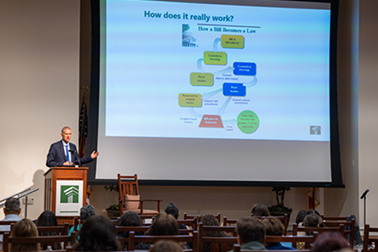
Save the Date for the Workers’ Compensation Symposium
By Jeff Rush, Workers’ Compensation Program Manager
Mark your calendars for the Workers’ Compensation Symposium on August 14, 2025, from 9:30 a.m. to 1:30 p.m. at the Authority’s La Palma campus. This year’s Symposium features a variety of sessions touching on multiple aspects of the workers’ compensation system. Members can learn and discuss pertinent subjects related to their agencies’ workers’ compensation programs.
The program comprises five presentations highlighting a variety of topics pertinent to the process of managing both a workers’ compensation program and individual claims. “This year’s Symposium includes presenters who bring unique perspectives on the system and the impact it has on our members and their injured employees,” said Jeff Rush, workers’ compensation program manager.
Schedule highlights include:
9:45 a.m., Dr. Glen Apramian from St. George’s Medical Clinic will provide an overview of the occupational medicine process and what he looks for when evaluating an injured employee.
10:30 a.m., Raja Sundaram from Plethy will discuss his company’s Recpue program and its use of technology to aid injured workers during their recovery from an industrial injury.
11:00 a.m., Mary Linn Moore from ISYS will discuss the “Utilization Preview” program the Authority has implemented in the last year to improve the utilization review process on behalf of injured workers.
11:15 a.m., Gideon Baum, the President of the California Workers’ Compensation Institute, returns to discuss some of the Institute’s groundbreaking research into the workers’ compensation system as well as some of this year’s pending legislation.
12:45 p.m., Jeff Rush, Chrisi Salazar from Athens Administrators, Catherine McWhorter from Valencia & McWhorter, and Chris Griffin from Griffin, Lotz & Holzman will discuss some of the hidden benefits of workers’ compensation settlements and creative approaches for getting claims resolved.
“I’m looking forward to sharing information about the medical, legal, and legislative aspects of the workers’ compensation system that have a significant impact on how claims are handled in California,” said Rush.
The symposium promises to be informative and engaging while offering attendees the opportunity to meet members of our claims team at Athens and some of our panel attorneys.
For more information about how to participate in the symposium, please visit the event website or contact Jeff Rush by email or at (562) 467-8707.
Print Article
RE: MEMBERS
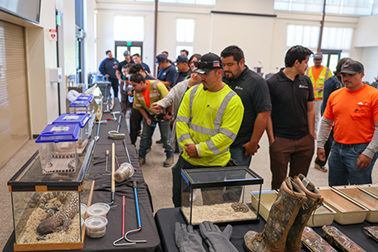
Celebrating National Public Works Week with the City of Santa Clarita
Cities across the United States celebrated National Public Works Week from May 18 to 24. The 2025 theme, “People, Purpose, Presence,” highlights the cornerstone ideals that motivate public works professionals to serve in their communities every day. The week is an opportune time to recognize and celebrate public works employees’ role in shaping our communities.
This year, the Authority highlights the City of Santa Clarita’s Public Works Department and its commitment to employee safety. The department incorporates comprehensive safety measures into managing and inspecting capital improvement projects, promoting active transportation, overseeing private development design and permitting, planning and building sidewalks and medians, partnering with the community to improve neighborhoods, and maintaining the city’s network of roadways, bridges, and infrastructure.
Risk management and human resources have worked together to weave risk management into the department’s culture. This has created a supportive environment for employee well-being through targeted training and updates. They assign safety training to new hires, have post-mortems to discuss incidents and injuries, monitor the long-term impact of employee injuries, and provide specialized and supervisor training.
“All of these actions help to increase trust in the organization’s commitment to employee health and well-being,” said the city’s Risk Management and Safety Technician, Cindy Perez-Enriquez. “We have a feedback loop where stakeholders are updated during quarterly manager and supervisor meetings, safety committee meetings, employee newsletters, and the employee intranet. Every step of the process is collaborative.” Safety committee members also act as an extension of risk management, educating and informing staff across the organization of the safety efforts.
Recognizing workplace hazards and communicating with risk management for support is facilitated by managers and supervisors. These relationships are crucial for team buy-in of the process and training. “Risk management works with various departments and the California JPIA to tailor training sessions to specific job needs,” said Perez-Enriquez. “They ensure training is instructive, and the efforts foster trust, shared understanding, and help identify future needs.”
In addition to training, the department conducts regular mock-OSHA inspections to proactively identify and address potential risks. These inspections, carried out with their Authority Senior Risk Manager, Tim Karcz, help maintain a safe working environment and foster a culture of shared responsibility.
“Santa Clarita’s commitment to sound risk and safety management practices is matched only by their dedication to maintaining a safe and healthy community for residents to thrive in,” said Karcz. “Their specialized training programs include rattlesnake handling sessions and driver safety obstacle courses, ensuring employees are well-prepared for unique challenges.”
Keeping safety top of mind is especially important considering the department’s responsibilities. The General Services Division is responsible for maintaining the City’s streets and vehicle fleet. In 2024, the street maintenance team completed over 850 sidewalk repairs in-house, repaired over 1,500 potholes, and replaced over 1,900 traffic and roadway signs. Vehicle maintenance was completed, and over 800 scheduled and 1,200 unscheduled repairs were made to the city’s fleet. General Services maintains an annual inspection and repair schedule for sidewalk rehabilitation. The team also completes citywide guardrail repairs, installation, and removal of over 300 flags and banners for the Hometown Heroes banner program and completes right-of-way beautification and weed abatement programs.
Success in risk prevention is measured both quantitatively and qualitatively. Positive employee feedback, strong management involvement, and visible safety culture in daily operations also signify success. “We track incidents, workers’ compensation claims, and training completion rates,” said Perez-Enriquez. “When staff is actively engaged in safety initiatives and programs, we celebrate these proactive safety ‘wins.’”
Authority members wishing to incorporate more risk management and employee safety strategies into their public works department should contact their regional risk manager for information.
Print ArticleRISK SOLUTIONS
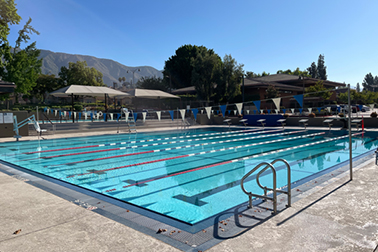
Preparing for Summer
While summer creates wonderful opportunities for communities to get together for activities ranging from Independence Day parades to Little League baseball games, the season challenges public agencies to manage the risks associated with increased use of facilities such as parks, playgrounds, and swimming pools. The California JPIA offers many resources to help safeguard vulnerable populations and ensure that municipal summer gatherings go off without a hitch.
Aquatics
Injuries at member-owned swimming pools and aquatic centers can be traumatic and costly. This exposure can be managed in several ways:
- Ensure lifeguards are trained to follow specific operational and emergency procedures and possess current lifeguard and first aid/CPR certifications.
- Regular in-service training can provide lifeguards with simulated experiences of potential real-world incidents (e.g., victim retrieval, unruly patron intervention, etc.).
- Regularly inspect the pool, locker rooms, showers, and other facility areas to identify and correct hazards such as broken glass, bodily fluids, inappropriate behavior, etc.
- Ensure that rescue equipment such as backboards, rescue tubes, and throw ropes is readily accessible and that staff is trained to use these devices effectively.
First Aid/CPR
Larger crowds, coupled with higher temperatures during the summer months, increase the likelihood of agency staff needing to respond to an ill or injured colleague or member of the public. California JPIA members can improve the odds of a favorable outcome by ensuring that key staff is formally trained in first aid, CPR, and AED use. The Authority offers American Heart Association (AHA) first aid, CPR, and AED training to members at no additional cost. The AHA requires re-training every two years; review your records to determine if employee certifications have expired.
Park Maintenance
While maintaining safe park and playground environments is essential at all times of the year, the months before summer are an apt time to review your agency’s inspection and maintenance program and to conduct audits by Certified Playground Safety Inspectors (CPSIs). You can locate a CPSI in your area through the National Recreation and Park Association (NRPA) website. A Park & Playground Inspection & Maintenance Policy template can be found in the library section of cjpia.org.
Special Events Program
Summertime also increases the number of special events hosted by public agencies. Event organizers or the public wishing to use member-owned facilities may need help to obtain the minimum general liability insurance limits recommended (typically $1 million per occurrence). The Authority’s Special Events Program can help by providing general liability insurance when member-owned premises are used for special events or short-term activities. Examples include weddings, art festivals, parades, yoga classes, and member-sponsored events such as fairs, carnivals, and swap meets. This coverage is not deductible, and members are automatically included as additional insured. For more information, visit the special event program page of the California JPIA website.
Abuse Prevention Resources
It is crucial to address the protection of vulnerable populations during seasonal programming. The California JPIA partners with Praesidium, which offers educational resources to help agencies understand and manage risks related to abuse and molestation. Resources include a helpline, model policies, screening and selection, crisis response toolkits, and multiple online, self-paced trainings. For more information and to access these resources, please visit the Praesidium webpage.
As we gear up for the summer season, it’s imperative to remain vigilant and proactive in managing risk. By implementing the above strategies and utilizing available resources, public agencies can ensure the safety and well-being of all community members.
Training
The Authority provides numerous in-person, virtual instructor-led, and online self-paced training modules ideal for assisting staff in handling the unique risks associated with summer activities.
These training opportunities include:
- Aquatics Center Operation
- Customer Service: A Team Effort
- Code of Quality Service – Virtual
- Customer Service & De-Escalation for Public Agencies: Strategies for Success
- CPR/AED/First Aid Safety
- CPR/AED/Pediatric First Aid
- Dealing Successfully with Customers
- Hearing Conservation
- Heat Illness Prevention
- Library Service, Safety, and Security
- Mandated Reporter Training
- Playground Safety
- Part-Time, Seasonal, and Temporary Employees and Volunteers
To sign up for training, contact your agency’s training registrar. If you have questions or want more information, please contact your regional risk manager.
Print Article
Risk Managers Roundtable Highlights the Importance of Cyber Resilience
As part of the California JPIA Risk Managers Roundtable series, the Authority recently hosted an insightful webinar discussing the new National Institute of Standards and Technology (NIST) Cybersecurity Framework (CSF) 2.0. The session was presented by Paul Edge, CEO of Triden Group, the Authority’s cybersecurity business partner. Edge explored the importance of aligning cybersecurity posture with the updated NIST CSF 2.0 to strengthen organizational resilience, improve executive-level decision-making, and reduce cyber risks. Participants also learned how adopting the framework supports cyber insurability, helping members meet underwriting priorities such as:
- Multi-Factor Authentication (MFA)
- Endpoint Detection and Response (EDR)
- Regularly tested, isolated, immutable backups that can be reliably restored
- Documented incident response plans
- Regular vulnerability scanning
- Employee security awareness training
These practices improve insurability and align with NIST’s core focus areas of protecting and recovering from cyber threats.
Additionally, Edge highlighted common gaps identified among California JPIA member agencies, including:
- Inconsistent patch management
- Lack of formal cyber risk management processes
- Missing incident response plans
- Limited threat detection tools (Managed Detection and Response (MDR)/EDR)
- Over-reliance on Managed Service Providers (MSPs) without adequate oversight of MSP security practices
For those Authority members unable to attend, the recording is available using the webinar link.
As a reminder, members have access to fully funded cybersecurity services through the Authority’s partnership with Triden Group, including:
- A cybersecurity maturity assessment based on the NIST CSF
- Internal and external vulnerability scans to help identify and address security gaps
Additionally, the Authority has also secured a Master Services Agreement with Triden, allowing members to engage them directly—at preferred pricing—for services such as:
- Penetration testing
- Incident response tabletop exercises
- Cybersecurity training
- Follow-up assessments
Finally, the Authority also offers the following member resources:
- KnowBe4 for security awareness training and phishing simulations
- Eagle Eye, a cyber risk management platform with checklists, website assessments, and tracking tools
- eRiskHub, an online portal with incident response planning tools, policy templates, and more
If you are interested in any of these services or need help accessing the services, please contact your regional risk manager.
Print Article

